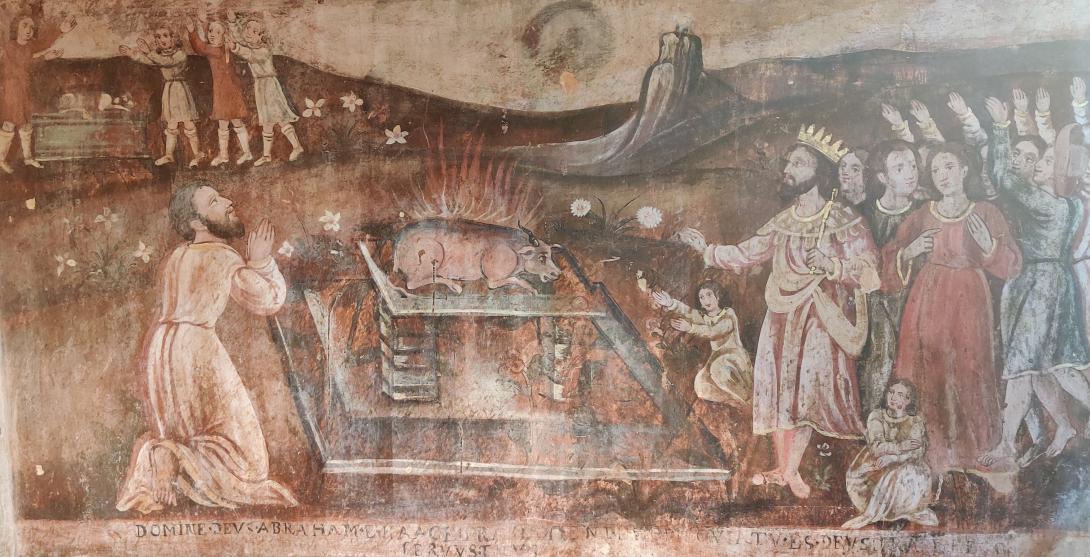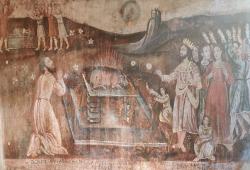
A valuable treasure trove of art work, murals, frescoes and paintings lie in a 16th century monastery in old Goa, hidden from the world except on one day each year when they are opened to visitors who are taken on a tour. So very few people know about it.
One can now get to see them on screen, thanks to an unusual documentary film made by Omkar Bhatkar of the St Andrew’s centre for philosophy and performing arts in Bandra, Mumbai. He calls it Painted Hymns and has used a lot of poetry, music and enacted scenes from Jesus’s life in the film which had its first screening in St. Andrew’s on July 16.
The art work depicts birds and animals in a caring manner which is so important in our human-centred ethos
Heta Pandit, a founder member of the Goa Heritage Action Group and a member of the Museum of Christian Art, who was present at the screening said the film lets the viewer see details which might have been missed during the actual viewing of the original work in the monastery. The art work depicts birds and animals in a caring manner which is so important in our human-centred ethos. The nuns and other artists who did the work seem to have been very well versed in botany and ornithology.
The film maker could get access to this wonderful work because of special permission given by the church authorities in Goa. The film is an attempt to document these fading murals in a poetic form. As very little is known about them to be depicted in a documentary format, the film uses handpicked poetry from world literature spanning across time and cultures. The poems used include Rainer Maria Rilke, Rumi, Khalil Gibran, Gabriela Misrtral, Chistian Wiman, Dorothy Wayland, Edward Caswall, Jean E Jones, St. John of the Cross, G K Chestron, Gabriela Mistral.
This film is an attempt to document the murals and paintings in a poetic form especially as some of them are rare and possibly not present anywhere else in the world, especially the ones in the chapel of Trinity. The paintings are painted over the walls with brushes dipped in natural vegetable dyes and reflect a love for flora and fauna.
The Convent of Santa Monica stands atop the Monte Santo, resolutely facing north. Like a grand old matriarch, the nunnery stands not just with grace and dignity but with formidable beauty and an air of insurmountable defenses; tenderly sheltering those within whilst repelling the whims and fancies of the fickle, shallow world, says a write-up on Santa Monica. Believed to be the world’s second-largest convent, the construction of Santa Monica began in 1606 and was finished in 1627. The convent had eleven private chapels of which only three survive today. This film is an attempt to document the murals and paintings in a poetic form especially as some of them are rare and possibly not present anywhere else in the world, especially the ones in the chapel of Trinity. The paintings are painted over the walls with brushes dipped in natural vegetable dyes and reflect a love for flora and fauna. The Chapel of the Holy Trinity is like Goa’s secret Sistine chapel and the film is somewhere between a documentary and visual theology.
A unique church with Portuguese ancestry is an old Mumbai church which is opened to the public only once a year, this church in Andheri is the only 'roofless church’ in the city where mass is still held.
The film maker Omkar Bhatkar, trained in sociology and is the co-founder and head of St. Andrews Centre for Philosophy and Performing Arts, an art and culture centre in Mumbai known for eclectic programs. He runs his own theatre group known as Metamorphosis Theatre. St. Andrew’s Centre for Philosophy and Performing Arts is where academicians, research scholars, students, culture enthusiasts, artists and community members work in a collaborative environment to create rich, engaged learning and teaching experiences in the field of Art, Literature and Performing Arts; the Centre is the first of its kind in Mumbai with academic courses in the specialised fields of art and culture open to all. The St. Andrew’s Centre is attributed to founders Fr. Magi Murzello and Dr. Omkar Bhatkar.
Mumbai has its share of old churches some of them abandoned, some of them unusual, some of them with a distinct Portuguese lineage. A unique church with Portuguese ancestry is an old Mumbai church which is opened to the public only once a year, this church in Andheri is the only 'roofless church’ in the city where mass is still held.
The church also had a graveyard and was abandoned in 1840 after an epidemic hit the village of Kondivita. José Lourenço Pais, the then vicar of Kondivita, transferred the church to the nearby Marol village.
Nestled inside the Santacruz Electronic Export Processing Zone (SEEPZ) complex, the original church at Condita was built by Jesuit priest Manuel Gomes in 1579. To mark the feast, parishioners carry the statue of St John the Baptist placed in their current church (St John the Evangelist) in Marol to the ruined church.
Abandoned and in ruins now, this 440-year-old church built by Portugese Jesuits was opened to public worship on the feast of John the Baptist in the same year. The church also had a graveyard and was abandoned in 1840 after an epidemic hit the village of Kondivita. José Lourenço Pais, the then vicar of Kondivita, transferred the church to the nearby Marol village. The baptismal font, pillars and altars were transferred to the new church.
According to the story of the Condita church that dates back to 1579 when Jesuit priest Manuel Gomes built it, a mass conversion in 1588 turned the whole village of Marol into Catholics.
The large Baobabs speak of the church’s Portuguese roots as these trees were planted here by the Portuguese priests. The ‘IHS’ Christian emblem (a monogram which represents the name of Jesus consisting of the three letters: IHS (during the Middle Ages, the Name of Jesus was written as IHESUS) is still visible over the arch on the left flank of the church, and the limestone walls with three arches are now supported by the roots of the medicinal Manila tamarind trees. According to the locals, the tiled roof was blown away during a severe cyclone in 1949, but a few tiles continue to hang precariously near the main entrance.
It took the parishioners eight days to transform the ruins into a church after removing the dried leaves, washing the altar area, painting the cross, cementing and levelling the altar so the older priests may find it easier to stand there. Only SEEPZ employees have access to these ruins, while the area is thrown open to the public only on the feast day till 3 pm. According to the story of the Condita church that dates back to 1579 when Jesuit priest Manuel Gomes built it, a mass conversion in 1588 turned the whole village of Marol into Catholics. In 1840, after the outbreak of a devastating epidemic, the Condita church was abandoned and a new one was built at Marol. Till 1973, Mass was celebrated annually in May at the ruins. The practice was discontinued when MIDC acquired the area around the church for SEEPZ and it was declared a high-security zone.
(Vidyadhar Date is a senior journalist and culture critic)







